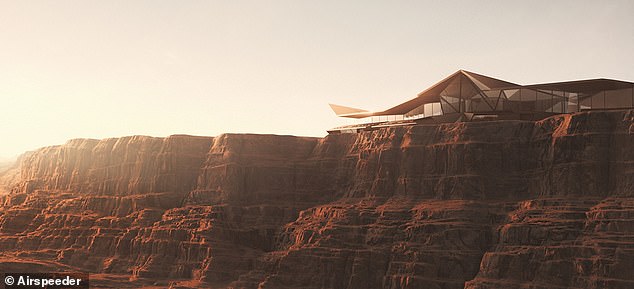At first glance, you’d be forgiven for mistaking them for stills from the latest film in the Dune franchise.
But the structure of the images could soon become reality, according to Airspeeder.
The company has unveiled its vision for the world’s first ‘vertiport’ for flying car racing.
The futuristic design features a 360° Skydeck where spectators can watch the aerial action, as well as retractable landing pads where flying race cars can stop to refuel.
“This innovative concept aims to revolutionize both the sport and the spectator experience, combining cutting-edge design with sustainability,” explained Airspeeder.
At first glance, you’d be forgiven for mistaking them for stills from the latest film in the Dune franchise. But the images could soon become reality, according to Airspeeder

Airspeeder is an electric flying car racing series based in London. He has unveiled his vision of the world’s first ‘vertiport’ for flying car racing
Airspeeder is an electric flying car racing series based in London, United Kingdom.
The company has already pitted remotely piloted flying cars against each other.
However, its ultimate goal is to host races in which fully crewed flying cars compete against each other, in what Airspeeder describes as a “Formula One of the Skies.”
Now, the startup has collaborated with global architecture firm HOK to imagine what the event space, or ‘vertiport’, for these races could look like.
“We believe flying car racing will usher in a new mobility revolution, driving E-VTOL and EV technology to the benefit of the entire industry,” said Stephen Sidlo, global media and marketing director at Airspeeder.

The vertiport has an “operations zone” with retractable landing platforms. This would allow teams to make mid-race pit stops to change batteries, ensuring “fairness and efficiency in the competition.”

Airspeeder says the design marks an “exciting step in the development of Airspeeder as a sport and as a vision for the future of mobility.”
“This collaboration with HOK represents not only a new sport but the future of sustainable, high-speed mobility.”
At the heart of the vertiport is the Skydeck.
This multi-functional center is located directly below the aerial race track and provides fans with an “unrivaled experience” of the race.
“The vertical nature of the setup offers a 360-degree experience, where spectators can see everything from the racing grid to mid-race pit stops and the finish line, all from one place,” Airspeeder said.
Skydeck is modular, meaning it can be completely disassembled or expanded.
“The design allows for easy expansion, ensuring the facility can grow alongside the Airspeeder series,” the company explained.
“Initially configured to accommodate up to 10 teams and 20 Airspeeders, the structure can be expanded to meet the changing needs of the sport, keeping pace with its rapid development.”
The vertiport also features an “operations zone” with retractable landing platforms.

The vertiport is just a concept, and it is not yet clear when or where it could become a reality, or how much it would cost to build.
This would allow teams to make mid-race pit stops to change batteries, ensuring “fairness and efficiency in the competition.”
The vertiport is simply a concept and it is not yet clear when or where it could become a reality, or how much it would cost to build.
However, the design has already sparked great interest on social media.
In response to Airspeeder’s tweet about the vertiport, one user wrote: ‘Looks amazing!’
Another added: ‘Cutting edge design meets futuristic racing! Exciting times lie ahead for aerial motorsport.’
And one joked: ‘Let’s fly baby!’
Airspeeder says the design marks an “exciting step in the development of Airspeeder as a sport and as a vision for the future of mobility.”
He added: “The modular vertiport is more than just infrastructure planning – it is a statement about the potential of eVTOL racing and the future of urban mobility at scale.”


